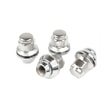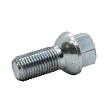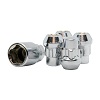Tire chains. How to install them correctly?
Steel tire chains are essential winter equipment for your car, ensuring safe driving in challenging snow and icy conditions. Proper installation of chains is crucial for efficient and safe winter driving. In this guide, we'll provide a step-by-step guide on how to properly install snow chains and how to care for them so they last for many seasons.
When to use tire chains?
Please note that tire chains should only be used when road conditions are particularly difficult, such as in deep snow or on icy roads. They are essential in areas where winter tires don't provide sufficient traction, especially in mountainous areas. Snow chains should only be used when conditions permit, to avoid damage to both the chains and the road surface.
The process of proper chain installation – step-by-step instructions
Installing snow chains yourself doesn't have to be difficult if you follow a few simple steps. Here's a detailed guide on how to install snow chains in winter conditions:
- Pre-installation preparation . Before beginning installation, stop the vehicle in a safe place and put on a reflective vest. Make sure you have enough space to work around the tire. Winter vehicle equipment should include both chains and a vest.
- Check chain compatibility . First, make sure the snow chains you choose are the right size for your vehicle's tires. You'll find this information on the chain packaging and in your vehicle's owner's manual.
- Lay out the chains on a flat surface . Lay the chains on the ground next to the tire they will be mounted on. Remove any kinks and inspect the chains for damage.
- Place the chains on the tire . Place the chains on top of the tire, starting from the top. Make sure the snow chains are evenly distributed across the tire and that the locking part is on the inside of the wheel.
- Engage the tie rods . First, connect the tie rods at the top of the tire, then the sides and bottom. Make sure all tie rods are securely fastened and that the tire chains are properly tensioned.
- Tighten your chains . After mounting the chains on the tire, drive the car for a few meters and then check the chain tension. Tighten them if necessary to prevent them from slipping off the tire while driving. This winter driving preparation will reduce the risk of skidding and accidents. Regularly checking chain tension is important, especially during long drives in difficult conditions.

Tips and tricks to make installing snow chains easier
Installing snow chains yourself can be a challenge, especially in harsh winter conditions. Here are some practical tips and tricks to make the process easier:
- Practice before your trip . Professional winter driving preparation should include practicing dry-fitting snow chains at home. This will help you become familiar with the process and make it much easier in challenging road conditions.
- Protective gloves . Always wear protective gloves when installing chains. They will prevent frostbite and abrasions, especially in frosty weather.
- Provide lighting . If installing tire chains after dark, use a headlamp or other light source to better see what you're doing. Good lighting is crucial for safe and efficient installation.
- Adequate work space . Make sure you have enough space to work around the wheel . If possible, park away from busy roads and on a flat surface.
- Pre-ride inspection . After installing the chains, it's recommended to drive a short distance and recheck that they are properly tensioned. Snow chains may loosen slightly after the first few kilometers of driving.
- Chain Cleanliness . Before installing, make sure your chains are clean and free of rust or other damage. Dirty or rusty chains can be more difficult to install and less effective. Remember that safe winter driving in challenging conditions depends largely on the equipment you use.
How to care for tire chains to make them last longer?
Taking care of your snow chains is just as important as installing them correctly. Here are some helpful snow chain tips to help keep them in good condition for many seasons:
- Cleaning after each use . After each use, it's important to thoroughly clean your chains. Remove any mud, snow, and road salt. These substances can accelerate corrosion and chain wear.
- Drying before storage . After washing your chains, make sure they are completely dry before storing them. Leaving them wet or damp can lead to corrosion.
- Store in a dry place . Store snow chains in a cool, dry place. It's best to use a special cover or box to protect them from moisture and other external factors.
- Lubricating the Chains . Preparing for winter driving can also include lubricating your chains. To prevent corrosion, you can apply a thin layer of oil or grease to the metal parts of your chains. This will provide additional rust protection, especially if you store your chains for extended periods.
- Avoid over-tensioning . Avoid over-tensioning the chains during installation. Too much tension can lead to premature wear or even chain damage.
- Avoid fast driving and sudden maneuvers . When driving with chains, avoid rapid acceleration, sudden braking, and sharp turns. Such maneuvers can damage the chains and tires.
Installing snow chains yourself may seem difficult, but with the right knowledge and practice, it becomes much easier. By keeping these tips and recommendations in mind, you can increase your safety and driving comfort during winter trips. Properly installed and maintained snow chains are invaluable equipment for every driver heading to the mountains in winter.




 Modern design
Modern design Perfect fit
Perfect fit High durability
High durability Free shipping within 24 hours
Free shipping within 24 hours
 Individual project
Individual project Dedicated caregiver
Dedicated caregiver









